

Price: $160
Weight: 1 lb. 9.4 oz. (men’s)
Waterproof: Yes (Gore-Tex)
What we like: Far less compromised in terms of durability and protection than most trail runners—great for fast-and-light hiking over technical terrain.
What we don’t: Too bulky and stiff for most trail runners; polarizing lacing system.
See the Men's XA Pro 3D V9 GTX See the Women's XA Pro 3D V9 GTX
Salomon is one of the biggest and most respected names in outdoor footwear, with an extensive lineup that spans the road running, trail running, and hiking categories. The XA Pro 3D, now in its 9th iteration, slots in as a crossover design—a shoe that’s built for technical trail running but that works well for fast-and-light hiking. We put the latest version to the test in rugged Chilean Patagonia and came away with mixed feelings: The XA Pro 3D isn’t the most modern design and lacks the plush comfort of many of our favorite trail runners, but it fills a nice gap for those looking for a traditional hiking shoe experience while keeping weight to a minimum. Below we break down the XA Pro 3D’s performance. To see how it stacks up to the competition, check out our articles on the best hiking shoes and best trail running shoes.
Although designated as a trail runner, many people use the Salomon XA Pro 3D for hiking, and we can see why. The shoe is relatively firm underfoot, but the trade-off is a solid connection with the ground. Coming from the thick Hoka Anacapa 2 Low GTX, which I was also testing in Patagonia, the XA Pro felt pretty natural in terms of stack height (28.7mm at the heel and 17.3mm at the forefoot) and overall form factor, making it an easy shoe to get to know quickly. And I appreciated the soft and well-padded tongue, which does a nice job preventing pressure points from the single-pull Quicklace system (more on the latter below). All told, the shoes were a great match for my testing itinerary, which included short (4- to 5-mile) and technical trail runs, two big day hikes with significant climbing, and substantial time off-trail.
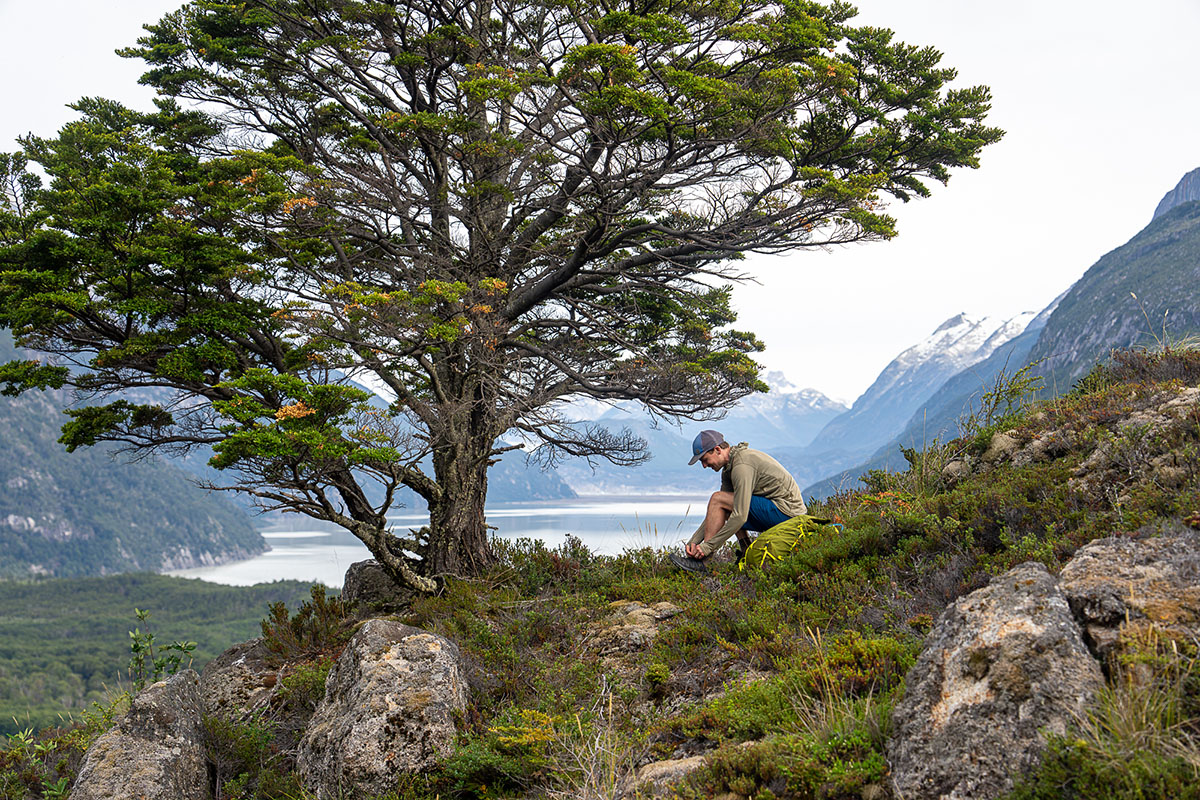
However, compared to more modern trail runners that cross over into the fast-and-light hiking world (like the popular Altra Lone Peak), the XA Pro 3D feels notably dated. In particular, I found the shoe to be relatively spartan and unpolished along the interior—akin to running shoes of old. Further, if you’re used to the integrated tongue that you get with some of Salomon’s other running models, including the Sense Ride 5, you might be disappointed with the XA Pro’s detached design, which adds bulk and makes the shoe less streamlined overall. For a sleeker, softer, and more modern design for hiking, we’d recommend a shoe like the aforementioned Lone Peak or Hoka’s plush Speedgoat 5 (both of which are lighter and sprightlier for trail running, too). But if you’re after the classic feel of a stable trail runner or firm hiking shoe, the XA Pro 3D fits the bill.
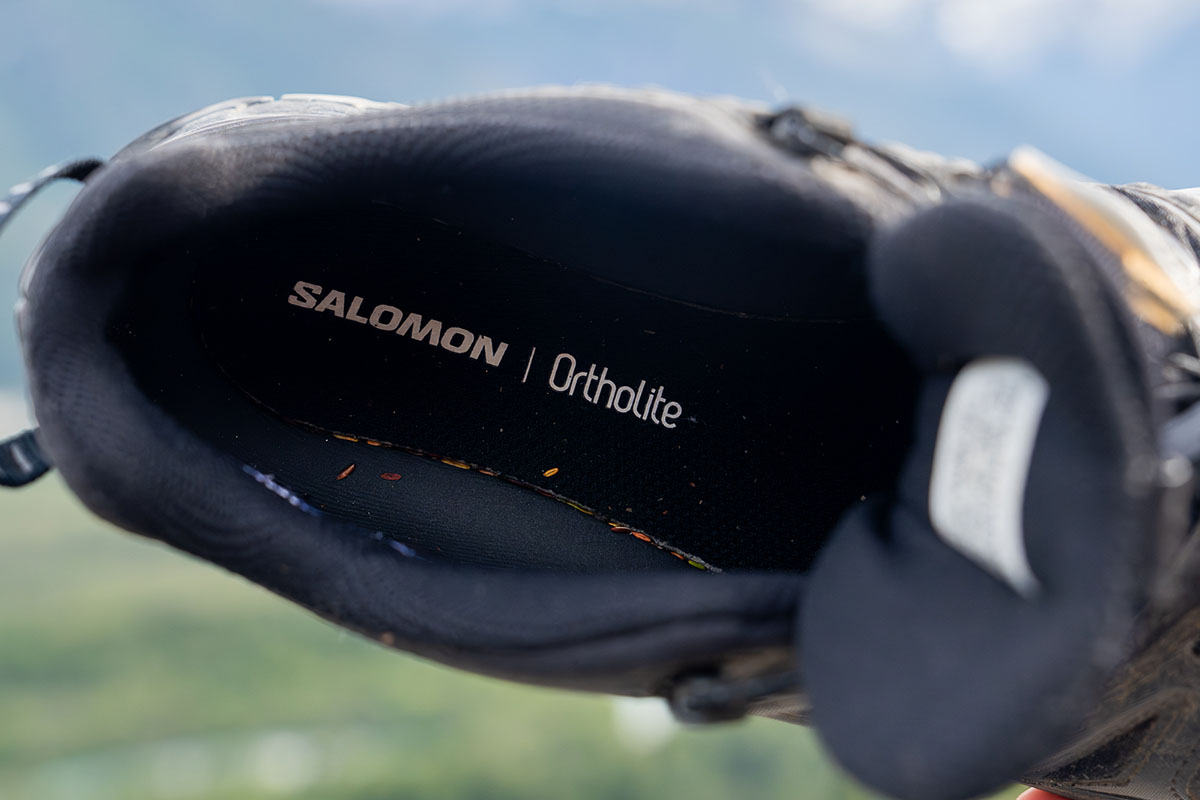
On the protection scale, the XA Pro 3D V9 is closer to a hiking shoe than a minimalist trail runner. The rubber toe cap is relatively large and burly and effectively shielded the front of my foot from several direct rock kicks. It’s a similar story underfoot, although the lack of cushion did result in some foot soreness after long days on the trail. It’s also worth noting that the top of the foot (which is comprised mostly of mesh) is pretty vulnerable to tears and snags from trail obstacles—when testing the past-generation model, a root easily abraded our tester’s skin through the toe box. But overall, the XA Pro 3D offers far better assurance than lighter and more streamlined options like the Lone Peak or Speedgoat.
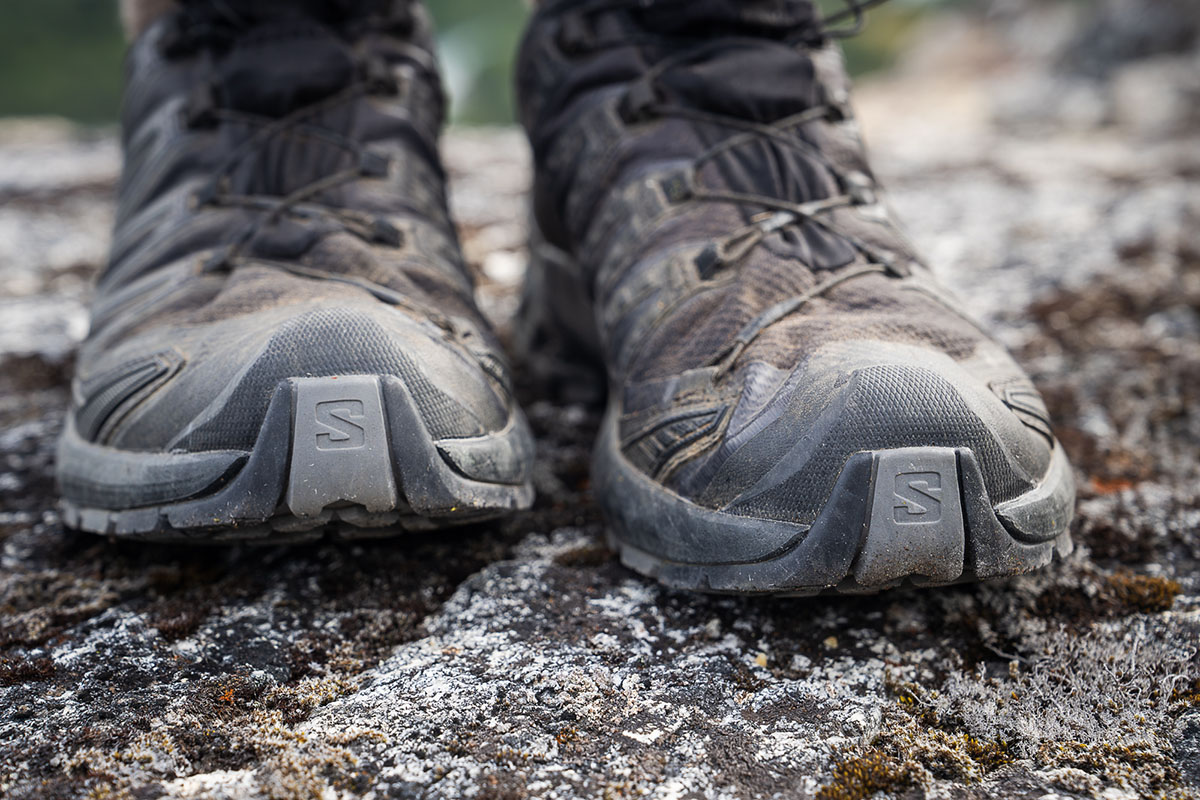
With a listed weight of 1 pound 9.4 ounces per pair for the men’s Gore-Tex version, the XA Pro 3D is lighter than many low-top hikers but heavier than its trail running competition. For comparison, Altra’s Lone Peak 8, which has similar crossover appeal, weighs 1 pound 5.4 ounces (the waterproof version is heavier at 1 lb. 10.4 oz.), although you do give up a fair bit of protection with such a lightweight build. Other versatile designs including the Hoka Speedgoat 5 (1 lb. 4.6 oz.), Brooks Cascadia 17 (1 lb. 6 oz.), and La Sportiva Ultra Raptor II (1 lb. 9 oz.) also undercut the XA Pro 3D in weight. On the other hand, the Salomon is lighter than traditional hiking models including the more durable and protective Merrell Moab 3 WP (1 lb. 10.1 oz.) and Oboz Sawtooth X Low WP (2 lb. 1.8 oz.).
The XA Pro 3D V9’s in-house Contagrip rubber outsole was serviceable on our trip to Patagonia but nothing to write home about. Coming from shoes with tacky Vibram Megagrip rubber (like Hoka’s Anacapa 2 Low and Mid), the difference was immediately noticeable: The XA Pro 3D didn’t stick as effectively to rock, was more prone to sliding, and had minimal bite in loose dirt and mud due to the relatively short lugs. The rubber is pretty tough and has withstood rough use without any signs of excessive wear, but it’s not as grippy as I’d prefer for a do-everything shoe.
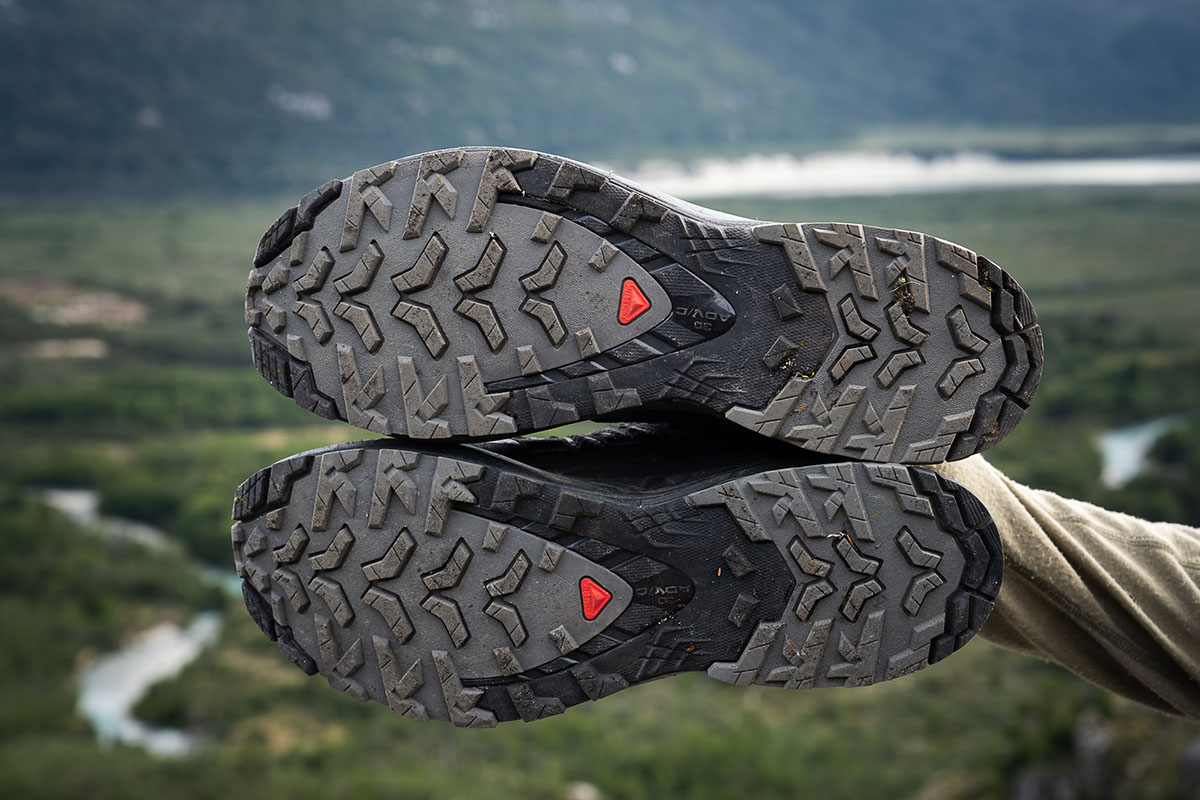
Continuing the trend, the XA Pro 3D V9 feels moderately stable for a trail runner but offers less support than a true hiking shoe. In particular, the heel is sturdy enough to feel solid when navigating tricky terrain without growing squirrely or unstable. I found the Brooks Cascadia 17 easier to trust on rough and off-camber ground, but the Salomon nevertheless is a tough shoe that doesn’t feel overly floppy when boulder-hopping or edging down loose terrain. Overall, the design should work well for most trails and carrying loads of 35 pounds or less, but I’d recommend upgrading to a stiffer shoe or full-on hiking boot for extended treks or when shuttling a heavy pack.
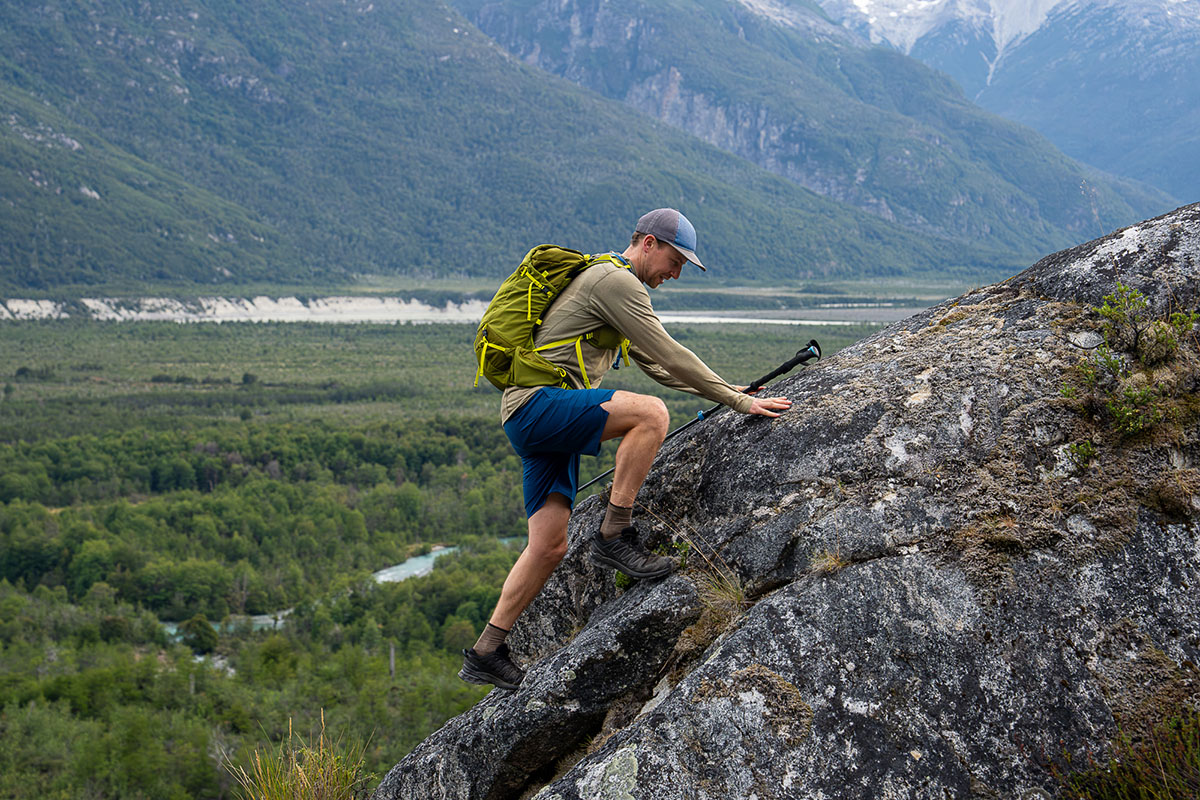
I tested the waterproof version of the XA Pro 3D V9, which boasts a proven Gore-Tex membrane for sealing out moisture. As expected, the shoes kept my feet perfectly dry in swampy conditions that included walking across long sections of soft, wet moss and through shallow puddles and pools. That said, not everyone will want to opt for the waterproof version: As with any low-top shoe, you always run the risk of water entering over the ankle, and breathability and drying time suffer as a result of the waterproof barrier. If you care more about the latter two, it’s worth saving $20 with the non-waterproof version of the XA Pro 3D.
The XA Pro 3D isn’t a standout in the breathability department, but it’s about average for a waterproof design. With temperatures reaching into the 80s Fahrenheit during our trip to Patagonia, my feet grew pretty warm in the black pair I was wearing. But still, that heat was entirely manageable. The shoes also did a decent job drying off after wear—they dried noticeably faster than the thicker and cushioned Hoka Anacapa 2 Mid boots I was testing alongside the XA Pro 3D. However, as we noted above, the non-waterproof XA Pro 3D will both ventilate better and dry quicker than the Gore-Tex model.
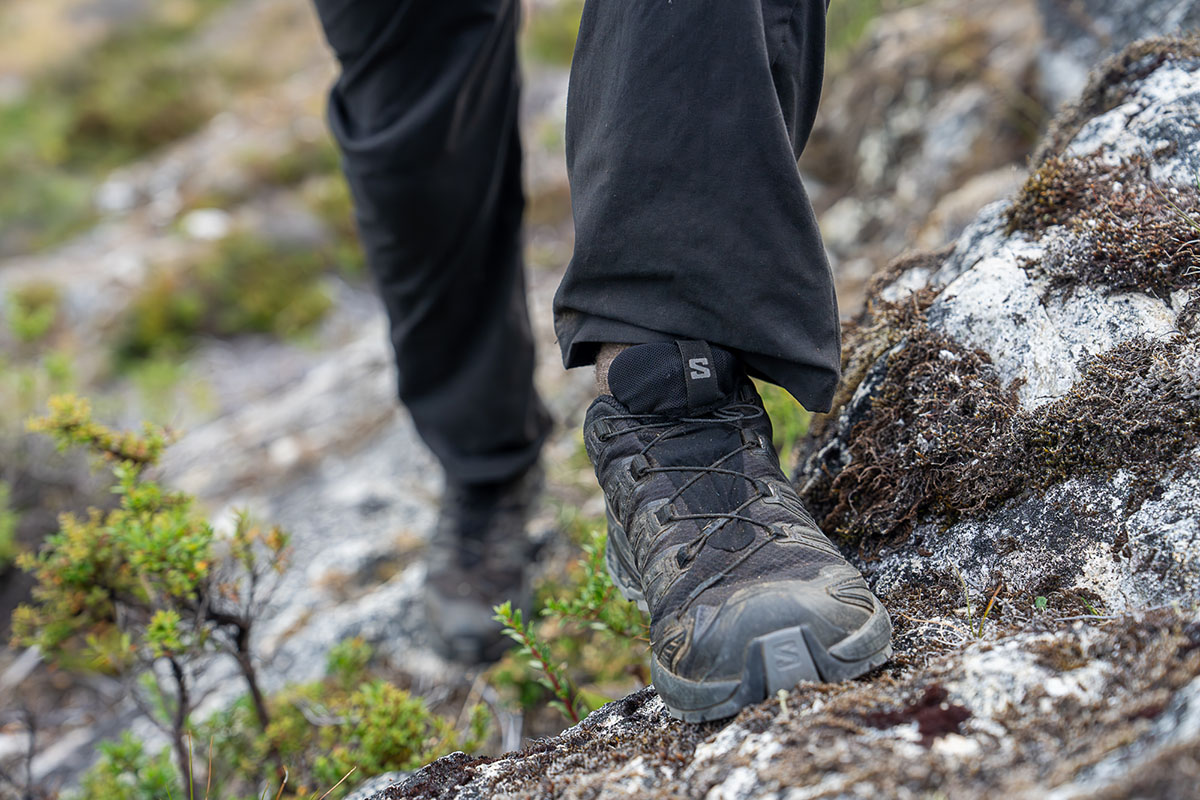
Salomon is a class leader when it comes to designing quality outdoor footwear, and the XA Pro 3D V9 is a testament to their expertise. Unlike lighter-weight models like the Altra Lone Peak and Hoka Speedgoat, the XA Pro 3D feels notably less compromised and delivers impressive durability that should hold up much longer to regular trail use. More specifically, the reinforced upper offers almost comprehensive protection from tears (minus right over the forefoot), and the burly sole and toe cap won’t wear out as quickly as these more minimalist models. To be sure, mesh will abrade and wear down faster than the highly durable leather found on many hiking shoes, but the XA Pro 3D is impressively hardwearing considering its intentions.
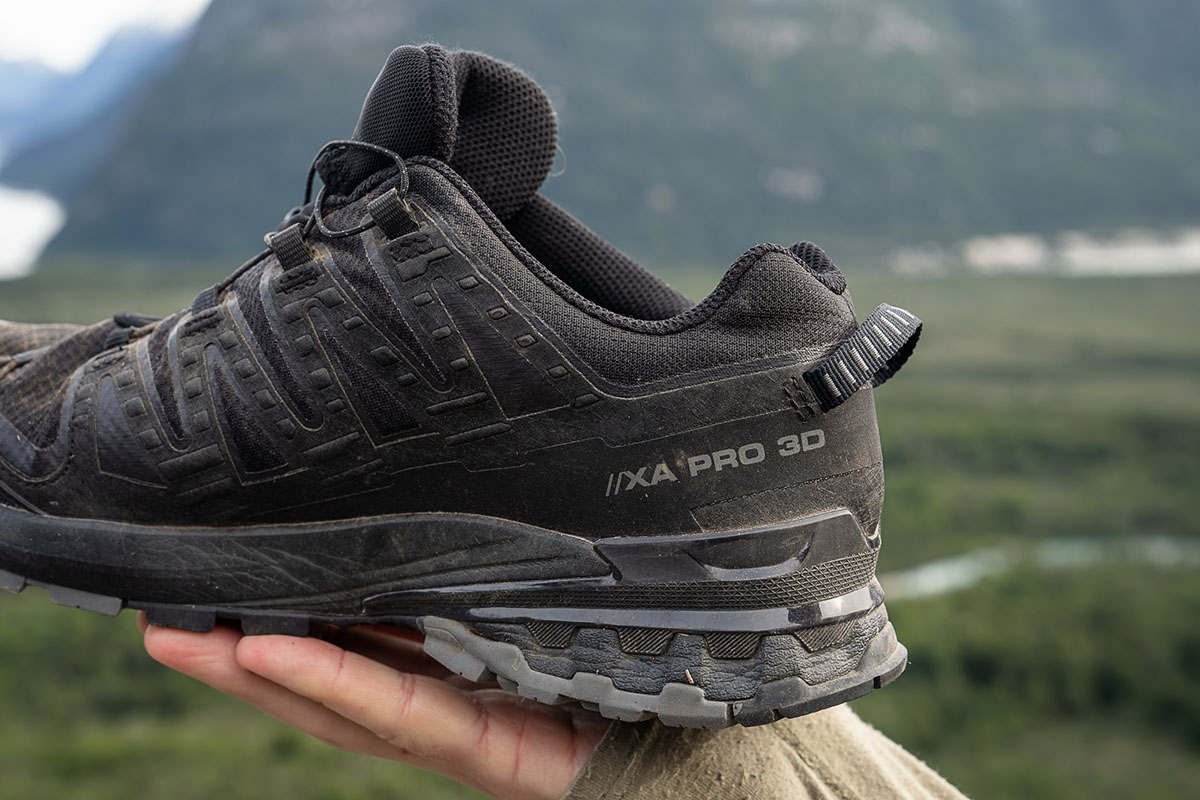
The XA Pro 3D V9 utilizes Salomon’s signature Quicklace system, which is a modern and more minimalist take on traditional laces. How it works: Pull on the rubberized end and push the plastic tab towards your foot to tighten, then reverse the process to loosen (it’s also simple to loosen with one hand by pulling up on the tab). In practice, I’ve found it’s easy to use, evenly snugs the laces around my foot (all the way down to the toes), and is reasonably quick and secure. The design is also sturdy and long-lasting—I haven’t had Quicklaces break or fail in a very long time.
That said, this isn’t my favorite application of the Quicklace system. Most annoyingly, the XA Pro 3D’s tongue gapes a lot when you store the laces and plastic tab in the underside pocket. It was enough of a problem that I opted to not use the pocket because of all the debris it invited into the top of my shoe. Instead, I secured the tab over the top of the tongue and the laces midway down the shoe, which left them vulnerable to brush that occasionally caught while walking. I also needed to retighten the laces more frequently than with a standard lacing setup, which only added to my dislike of the system. In the end, these won’t be dealbreakers for everyone, but they definitely detracted from the shoes’ overall performance for me.

I purchased my usual men’s size 9 in the Salomon XA Pro 3D and found the fit to be spot-on. Despite having narrow heels, I was able to get a good heel lock for steep climbs with the laces cinched tight, and the width felt average with a just-right amount of room in the toe box. For those with higher-volume feet, Salomon offers the shoe in dedicated wide sizes for men (both in waterproof and non-waterproof styles), although the women’s collection only includes the standard width.
Like many leading outdoor brands, Salomon has started employing more sustainable production practices, including the use of recycled materials. In this case, the XA Pro 3D V9 is made with 35% recycled content, although Salomon doesn’t specify which components fit the bill. And there’s certainly room for improvement—Hoka’s Anacapa that I was testing alongside the XA Pro uses bio-based materials for the liner and midsole—but we nevertheless applaud Salomon for boosting the shoe’s sustainability focus with the latest update.
We tested the men’s Gore-Tex version of the XA Pro 3D V9 for this review, which retails for $160. The shoe also comes in a non-waterproof version ($140) for men, which retains most of the same features and overall design but forgoes the Gore-Tex membrane for a boost in breathability and a small (2.6 oz.) drop in weight. For women, Salomon makes the XA Pro 3D in both non-waterproof (1 lb. 5.2 oz.) and Gore-Tex versions (1 lb. 6.2 oz.), which come in women’s-specific fits and colorways. As we touched on above, only the men’s versions are offered in wide sizes.
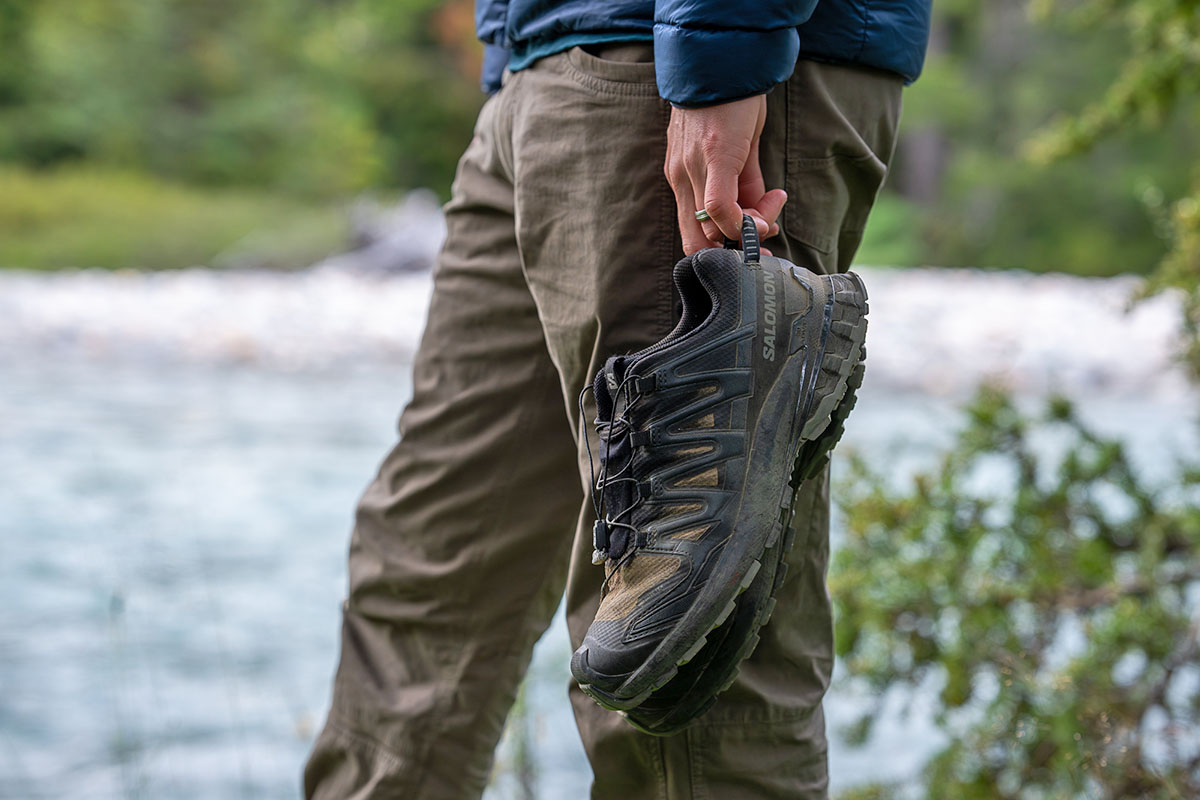
| Shoe | Price | Type | Weight | Waterproof | Upper |
|---|---|---|---|---|---|
| Salomon XA Pro 3D V9 GTX | $160 | Hiking shoe/trail runner | 1 lb. 9.4 oz. | Yes (Gore-Tex) | Synthetic |
| Altra Lone Peak 8 | $140 | Trail runner | 1 lb. 5.4 oz. | No (available) | Mesh |
| Brooks Cascadia 17 | $140 | Trail runner | 1 lb. 6 oz. | No (available) | Mesh |
| La Sportiva Ultra Raptor II | $149 | Trail runner/hiking shoe | 1 lb. 9 oz. | No (available) | Mesh |
| Salomon Sense Ride 5 | $140 | Trail runner | 1 lb. 4.2 oz. | No (available) | Synthetic |
| Salomon X Ultra 4 GTX | $160 | Hiking shoe | 1 lb. 11.5 oz. | Yes (Gore-Tex) | Synthetic |
The Salomon XA Pro 3D falls in a growing category of crossover shoes: running shoe-inspired designs that are popular for fast-and-light missions. In this category, the Altra Lone Peak is a real standout and one of the most popular options among thru-hikers and fastpackers. Recently updated to the “8,” the Lone Peak is lighter than the XA Pro 3D at 1 pound 5.4 ounces (1 lb. 10.4 oz. with waterproofing), with a more minimalist design that translates to a softer and more flexible ride (at the cost of durability and protection). The Lone Peak also uses a traditional lacing system that’s easier to customize and Altra’s signature zero-drop shape, which offers a wildly different trail feel than the Salomon’s 11-millimeter drop. In the end, we’d recommend the Lone Peak for most moderate trails, while the more protective and stiffer XA Pro 3D wins out on rugged terrain.
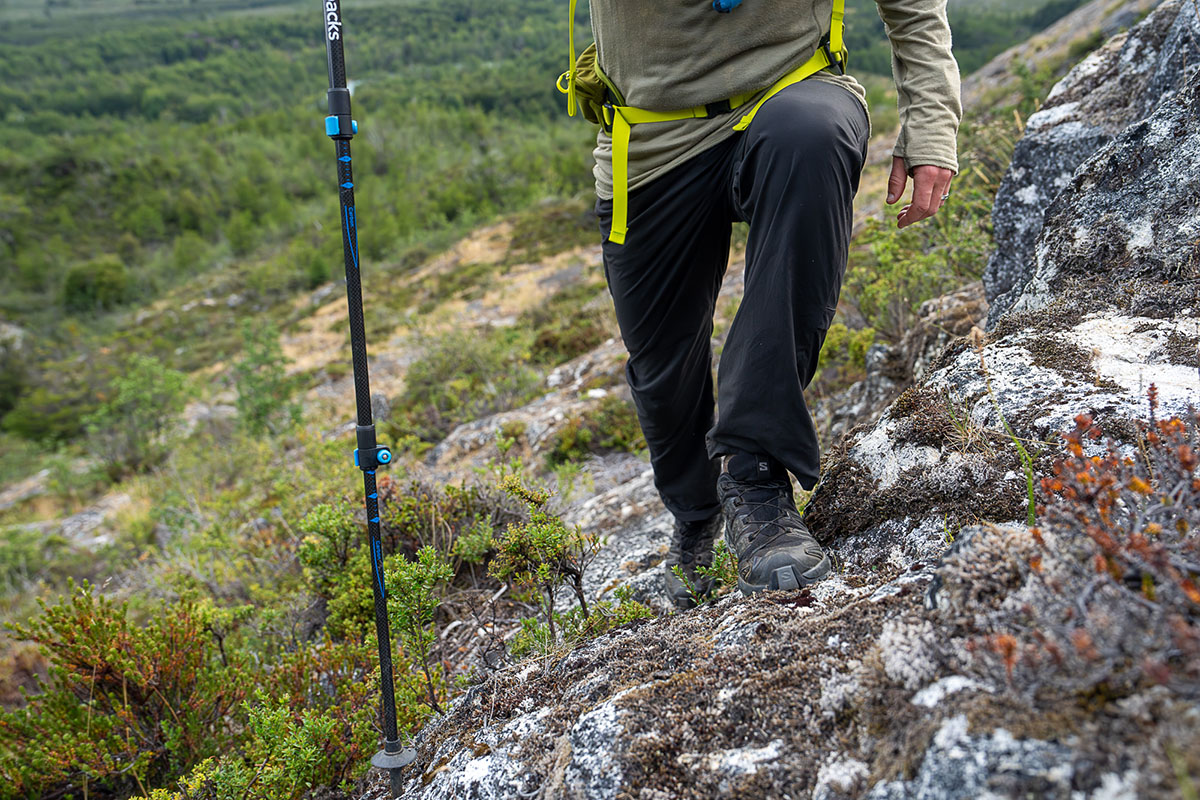
We’d be remiss not to mention the Brooks Cascadia here, which is now in its 17th iteration. Both the Salomon and Brooks are running designs that have become popular among the thru-hiking crowd, but the Cascadia 17 is lighter (1 lb. 6 oz. for the non-waterproof version; 1 lb. 7.4 oz. with Gore-Tex) and much more streamlined than the XA Pro 3D. That said, it still offers decent protection and features a rock plate in the outsole, which makes it fairly capable on rough terrain—capable enough that I prefer it over the Salomon on rough and off-camber ground, although the XA Pro is no slouch. Overall, we’d break it down as follows: The Brooks is the better trail runner and crosses over well for hiking, while the Salomon works best as a dedicated hiking shoe.
Next up is another crossover option that was quick to impress: La Sportiva’s Ultra Raptor II. Billed as a mountain running shoe, we’re big fans of the design for hikers venturing above treeline on rugged trails or cross-country terrain. Highlights include top-notch protection against rocks and roots by way of generous toe and heel caps and a full-length rock plate, along with incredible grip and ample cushion for all-day wear. Like the Salomon, the Ultra Raptor is relatively stiff and clunky for trail running, and the rigid TPU heel counter may cause discomfort for some. But overall, it’s an incredibly capable shoe for technical mountain travel and gets our vote over the XA Pro 3D as the better crossover design (for more, see our in-depth Ultra Raptor review). Of note: There’s also a Gore-Tex version available for $195.
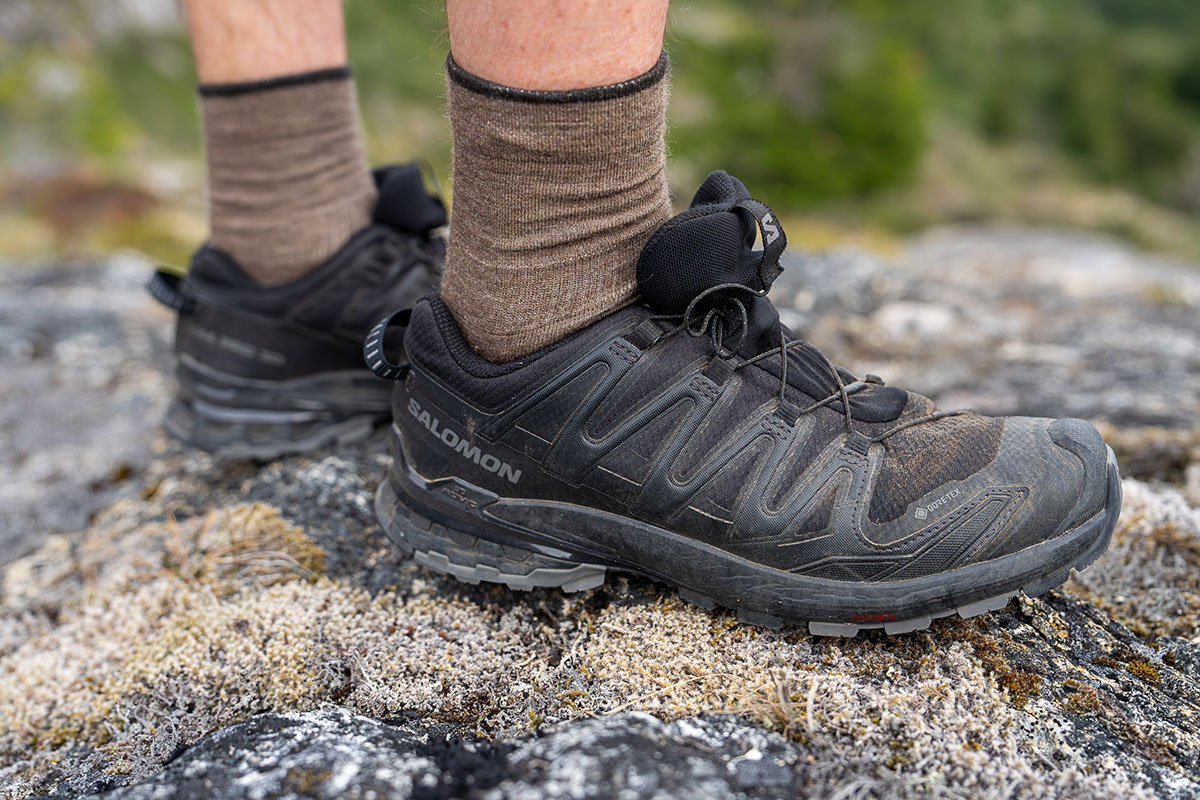
Last but not least are two shoes from Salomon’s own lineup to consider: the Sense Ride 5 trail runner and X Ultra 4 GTX hiking shoe. In our opinion, both designs do a better job than the XA Pro in their respective categories: The Sense Ride is much softer and more comfortable for trail running, has a lighter (1 lb. 4.2 oz.) and more agile build, and is equally at home on easy trails as it is on technical cross-country terrain. For dedicated hiking and lightweight backpacking, the X Ultra 4 is considerably more cushioned and capable with better protection and a more modern-feeling interior. It’s a little heavier than the XA Pro 3D at 1 pound 11.5 ounces per pair but has a very agile—yet entirely stable—feel. In the end, we’d point trail runners to the Sense Ride and hikers to the X Ultra, but the XA Pro 3D fills a nice gap between the two for those who don’t mind the stiffer and less forgiving platform.
If you’re thinking about buying gear that we’ve reviewed on Switchback Travel, you can help support us in the process. Just click on any of the seller links above, and if you make a purchase, we receive a small percentage of the transaction. The cost of the product is the same to you but this helps us continue to test and write about outdoor gear. Thanks and we appreciate your support!
Depending on the seller, most products ship free in the United States on orders of $50 or more. International shipping availability and rates vary by seller. The pricing information on this page is updated hourly but we are not responsible for inaccuracies.